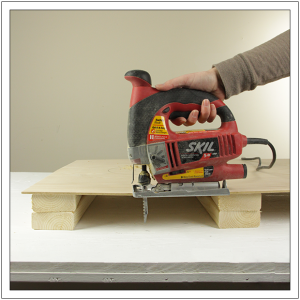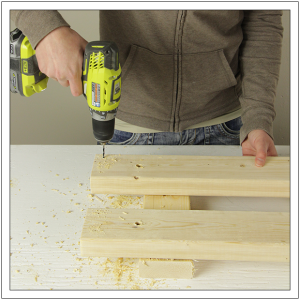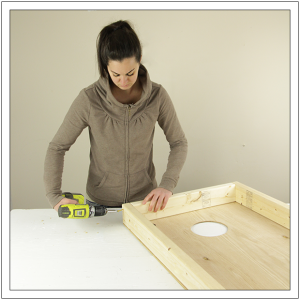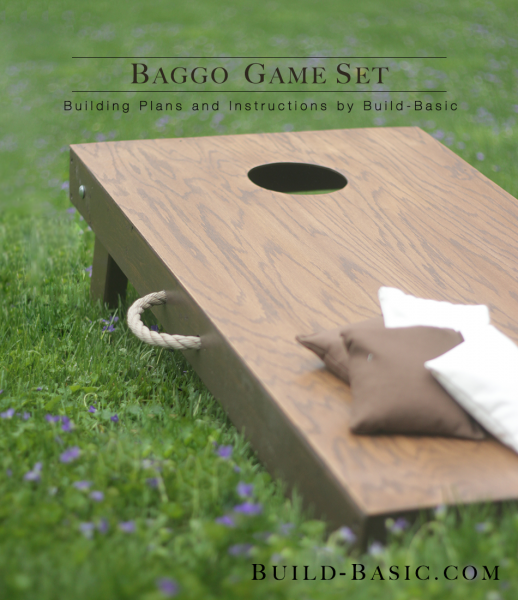If you’re from the Midwest like me, Baggo (aka Cornhole) is a staple at every family gathering, tailgate party, and any other outdoor gathering you can think of. The parts are easy to assembly, and the swing-out legs make it easy to stow away or take on the road. If you’re planning an upscale gathering, stain the deck boards a classic dark color like ours, or stencil in your favorite logo for game day. At 24×48 inches, our board is “competition size”, but the deck can easily be scaled down or the 2×4 frame swapped for 2x3s to make the assembly lighter on the go.
Cost: $35
Time: 3 hours
Difficulty: Easy. Basic cuts and straightforward assembly make this a quick and simple project.
(2) ¼-inch Plywood – Get 2×4 “project panels” at a homecenter
(4) 2x4x8 Boards to make the frames and legs
(4) 3/8 inch carriage bolt, washer and nut to secure the legs
(1) Rope to make the handles. Get a 3-foot length.
3 inch Wood Screws
1 inch Finish Nails
Wood Glue
Beanbags – I got mine at SC Cornhole Bags
¼ inch Plywood – 2 @ 24 x 48 inches
2×4 Frame Sides – 4 @ 48 inches
2×4 Frame Top and Bottom – 4 @ 21 inches
2×4 Legs – 4 @ 12 inches
Steps
1. Cut the 2×4 Pieces
Cut the 2×4 frame pieces and legs to size using a miter saw and the cut list provided above. Set the saw to 45-degrees and clip the top corners off each leg piece. Sand all the pieces in preparation for assembly.
 2. Mark the Bean Bag Hole
2. Mark the Bean Bag Hole
Using a tape measure and a pencil, make a mark in the center of each plywood deck 9 inches from its top edge.

3. Make a “Compass” tool
If you have a compass, set it to a radius of 3 inches and use it to draw a circle around the mark on each plywood deck. If you don’t have a compass, simply drill two holes 3-inches apart on a scrap paint stick and follow the next step to mark the circle.

4. Outline the Circle
Use a nail to secure one hole in the paint stick on the mark. Place a pencil in the second hole, and then rotate the paint stick around the nail. This will draw a perfect circle with a 3-inch radius.

5. Create an Entry Point for the Saw
Using a drill/driver and a large drill bit, create a hole inside the marked circle on each plywood deck. This will allow the jigsaw blade to start the cut inside each circle.

Tool Tip: Testing Saw Blade Depth
Before cutting a piece of wood, always create a level layer of support underneath to piece being cut. Once the board is elevated off the work surface, set the jigsaw along the edge of the board. Make sure the jigsaw is unplugged and the saw blade is in its lowest position. If the saw blade is at least an inch off the work surface, you’re ready to cut. Otherwise, add additional blocking to further raise the board.

6. Cut out the Circles
Place the blade of the jigsaw through the hole drilled in the plywood deck in step 5, and then cut out the marked circle from each piece.

7. Drill Bolt Holes in the Frame
On the long frame pieces, make a mark in the center of the board 3½-inches from each top edge. Drill a hole through the mark using a drill/driver fitted with a 3/8-inch drill bit.

8. Drill Bolt Holes in the Legs
Mark a hole in the center of each 2×4 leg piece that is 1¾ inches from its top edge. Drill a 3/8 inch hole through each leg.

9. Drill Pilot Holes
Using a drill/driver and a smaller pilot bit, drill two holes through the long frame pieces about ¾ inch from each end.

10. Attach the Rope Handles
Make two marks six inches apart in the center of two long frame pieces. Using the drill/driver and a paddle bit sized to the thickness of the rope, dill holes through each mark. Thread the ends of the rope through the holes in the frame. Secure the rope by tying a knot at the end on the inside of the frame board.

11. Assemble the Frames
Apply wood glue to the ends of two short frame pieces and position them between two long frame pieces. Be sure only use one frame piece with a rope handle per frame. Set the plywood underneath as a guide to help keep corners square. Using a drill/driver, secure the frame by screwing 3-inch wood screws through the pilot holes in the long frame pieces and into the ends of the shorter frame pieces.

12. Attach the Deck Boards
Place the frames side-by-side so the rope handles are next to each other. Mark the outside edge of each frame. This is where the plywood deck will be attached. Apply a bead of wood glue to the edge of the frame, and then set the plywood in place. Use a hammer to tap 1-inch finish nails through the plywood deck and into the frame. Secure a nail about every 8 inches.

13. Insert the Carriage Bolts
Position two legs inside each frame. Insert a carriage bolt through each hole in the frame and the hole in each corresponding leg.

14. Secure the Carriage Bolt
Beneath the round head of the carriage bolt is a square selection that needs to be sunk into the board to keep the bolt from spinning. To secure the bolt, tap the head with a hammer until the round head of the bolt sits flush with the surface of the wood.

15. Secure the Legs
Fit a washer onto the end of each bolt and tighten a nut securely against the inside of each leg. Lightly sand the deck board and apply a coat of stain or paint it you favorite team colors. Finish with two coats of polyurethane.
MORE BUILDING PLANS

 2. Mark the Bean Bag Hole
2. Mark the Bean Bag Hole
































Barry
What size and type of rope did you use for carrying handle?
Jenn Post author
Hi Barry,
I’m so sorry I don’t have specifics on the rope. I literally went to the spools at Home Depot and asked the clerk to cut me 3 feet of their thickest rope. Next time I’m there, I’ll swing by that aisle and try to grab the details! Sorry! –Jenn
Barry
Thank you so much for your quick response. I just discovered your website and l’m really enjoying it. Keep up the good work. Thanks again
Tom Greenwood
I don’t understand how the rope is attached and then used (to carry it?). A picture of the finished produst with rope in use would really help.
Carol Jewell
I made the game boards to your exact specifications and find that the boards are not sufficiently supported which results in a lot of bounce for the bean bags. My crowd objected so we’ve had to add cross supports underneath to reduce the bounce (tough crowd!) If I were to make this over, I would use 3/4 inch plywood for the top instead of the 1/4 inch called for.
William Gilles
What did you use to finish the wood?
Jenn Post author
Hi William,
For this project, I used Zar oil-based stain in their “Mocha” color, and finished with a few coats of polyurethane. Hope this helps! –Jenn
Anonymous
Bolt holes drilled in the side boards are not at 1 3/4″, more like 3 or 3 1/2″. In the picture you clearly did it correctly. But the directions should be corrected.
Jenn Post author
You’re absolutely right. Yikes! I just modified Step 7 to reflect the accurate measurement. My apologies for the error, and thank you for letting me know!